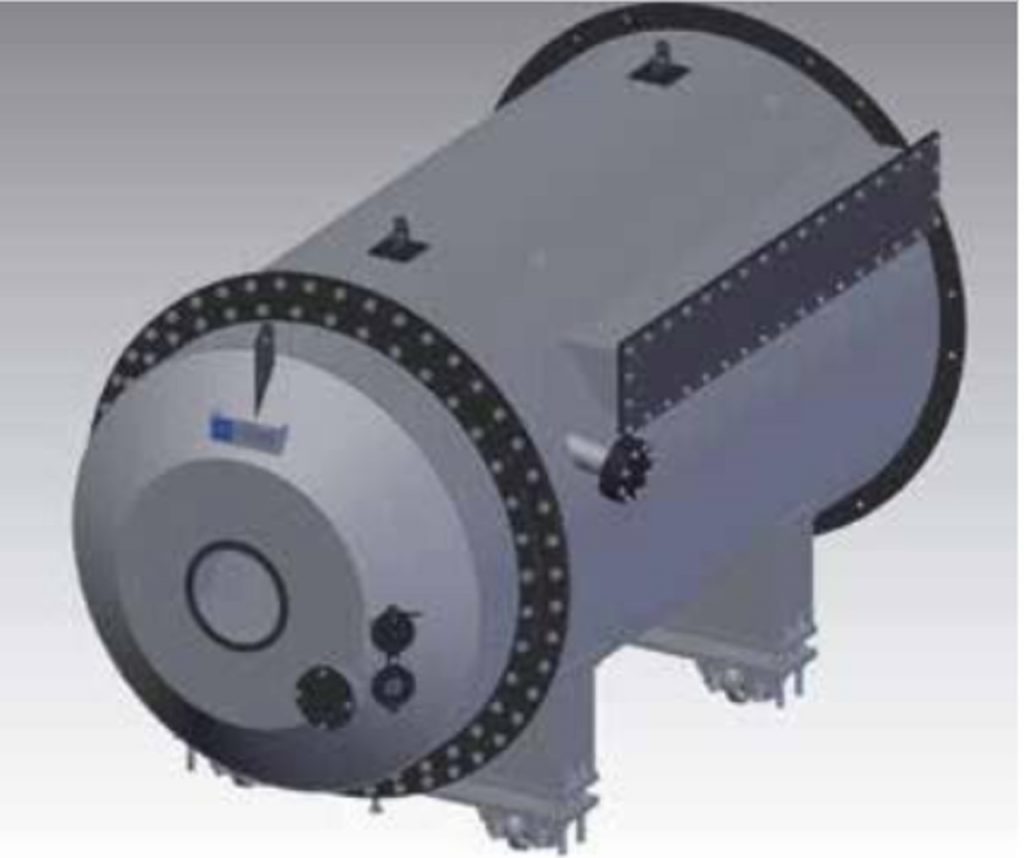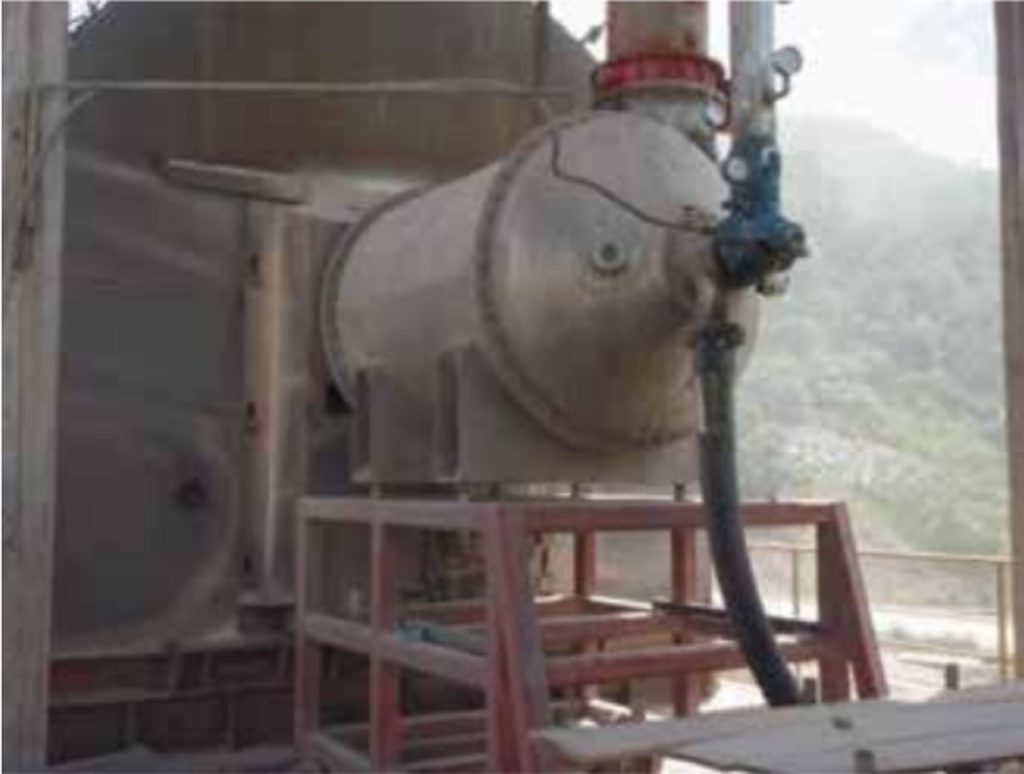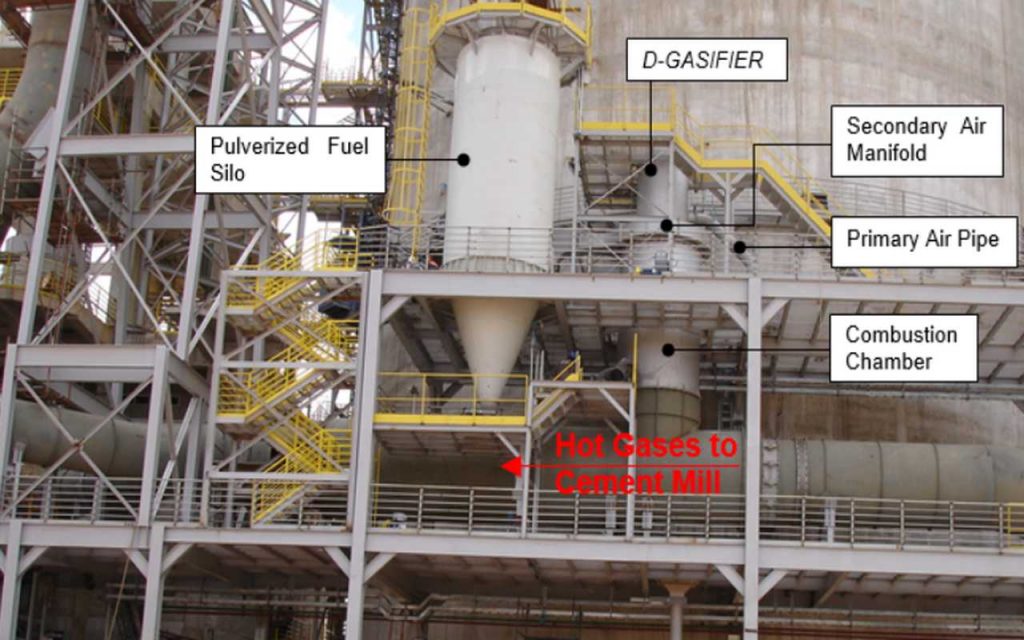Dynamis presents D-gasifier, a new gasifier that facilitates the use of solid fuels in combustion with low temperature processes.
The primary reason for using pulverised solid fuels instead of liquid and gaseous fuels is their comparatively low price; therefore, for a process in which fuel cost is critical, the replacement of a liquid or gaseous fuel by a pulverized solid one (coal, petcoke, biomass, etc) becomes quite an attractive prospect. The D-GASIFIER allows the use of 100% solid fuels in low temperature processes that normally run on gaseous or liquid fuels.

It can be used in a variety of applications, including rotary kilns, calciners and furnaces, dryers (rotary dryers, fluidised bed dryers, rapid dryers, flash dryers, etc.) and hot gas generators.
To begin operation, the D-GASIFIER must be preheated with an auxiliary fuel, which can be gaseous (e.g. natural gas, propane or liquefied petroleum gas) or liquid (e.g. diesel oil or heavy fuel oil). After the preheating period (between 45 and 60 minutes) the injection of solid fuel can be initiated. The process becomes self-sustaining at a given starting temperature and thereby requires no auxiliary fuel to ensure the stability of combustion.
As this equipment works as a gasifier (only part of the total air required for complete combustion is injected into the chamber), just a fraction of the fuel’s chemical energy is released inside the chamber. This results in a very compact design. As the D-GASIFIER is assembled over a carriage, it is easy to replace conventional burners (gas or oil fuel burners) and to pull the equipment back for refractory services in the kiln and even in the chamber.
Fuel Data
The D-GASIFIER can be used to burn a large number of solid fuels (coal, petcoke, biomass, etc). If required by the user, the auxiliary burner (for liquid or gaseous fuel) can be designed to reach the full capacity of the equipment.
Currently there are several chambers operating at 100% petcoke. Others are operating with light fuel oil or heavy fuel oil.
Petcoke typical data – example
- Origin: Corpus Christi, Texas.
- Proximate analysis (wet sample) – see Table 1.
- Ultimate analysis (dry sample) – see Table 2.
- Lower heat value: 8130 kcal/kg (14 665 Btu/lb) – dry sample.
- Hardgrove grindability index: 55 a 58.
Coal reference data
- Origin: Powder River Basin, Wyoming.
- Proximate analysis (wet sample) – see Table 3.
- Ultimate analysis (dry sample) – see Table 4.
- Lower heat value: 6180 kcal/kg (11 150 Btu/lb) – dry sample.
Light fuel-oil data
- Ultimate analysis (dry sample) – see Table 5.
- Lower heat value: 10 180 kcal/kg (18 360 Btu/lb).
| Table 1. Petcoke typical data – proximate analysis | |
| Component | Content (% mass) |
| Volatile matter | 11.18 |
| Fixed carbon | 82.14 |
| Ash | 0.4 |
| Moisture | 6.28 |
| Table 2. Petcoke typical data – ultimate analysis | |
| Component | Content (% mass) |
| Carbon | 86.57 |
| Hydrogen | 3.25 |
| Sulfur | 5.5 |
| Nitrogen | 1.67 |
| Others | 3.01 |
| Table 3. Coal reference data – proximate analysis | |
| Component | Content (% mass) |
| Volatile matter | 35.6 |
| Fixed carbon | 35.7 |
| Ash | 5.2 |
| Moisture | 23.5 |
| Table 4. Coal reference data – ultimate analysis | |
| Component | Content (% mass) |
| Carbon | 69.42 |
| Hydrogen | 4.45 |
| Oxygen | 17.93 |
| Sulfur | 0.35 |
| Nitrogen | 0.97 |
| Ash | 6.88 |
| Table 5. Light fuel-oil data – ultimate analysis | |
| Component | Content (% mass) |
| Carbon | 85.8 |
| Hydrogen | 13.5 |
| Oxygen | 0 |
| Nitrogen | 0 |
| Sulfur | 0.7 |
System description
Figure 1 illustrates the general arrangement of a typical combustion system. The main components of the combustion system are outlined below.

The D-GASIFIER chamber is the equipment responsible for the solid fuel ignition before it is injected into the rotary kiln, calciner or combustion chamber, depending on which process the new equipment will be adapted to. This chamber will work as a gasifier, generating a hot stream of gaseous fuel from the solid fuel injected.


To reach this objective, the D-GASIFIER has a number of important features:
- High temperature: the average temperature inside the chamber is in the range of 2700 ˚F – 2800 ˚F. The high temperature improves fuel ignition, accelerates exothermic reactions and displaces reaction equilibrium towards oxidation (even if the oxidation reactions are not completed).
- High turbulence: the combustion air is injected tangentially through several nozzles drilled along the chamber shell. This promotes high swirl inside the chamber, the main feature of this equipment. This high swirl, in conjunction with high injection velocity, promotes intense turbulence inside the chamber, thereby accelerating the mixture between fuel and combustion air.
- High residence time: the high swirl keeps fuel particles spinning inside the chamber until they are burned. The larger the mass of the particle, the longer its residence time inside the chamber.
Chamber Trolley
The D-GASIFIER has a very compact design. When horizontally mounted and installed on a trolley it facilitates maintenance of the chamber and of the equipment it attaches to. The trolley is built with steel bars and has four wheels, which allow free displacement of both components.

Primary air system
The primary air system is composed of:
- A primary air fan.
- A primary air fan drive – electrically powered by a frequency inverter.
- Instrumentation – low meters and pressure gauges;
- Control valves;
- Auxiliary valves, hoses and pipes.
In this system, the primary airflow rate must be adjusted as a function of the fuel flow rate injected into the chamber. The primary air ratio (related to the stoichiometric air) is usually maintained below 40% to avoid thermal damage to the refractory lining.
The variable speed of the primary air fan controls the primary airflow to the chamber. Control valves are used to divert part of the primary airflow to the preheating burner to cool it down.
Dosing system
The fuel injected into the chamber can be dosed either gravimetrically or volumetrically and its flow rate is increased or decreased as a function of the total energy required by the process (the kiln, calciner or dryer).
Fuel flow rate is the main information for the gasifier managing system (GMS). This control system is in charge of adjusting the primary airflow as a function of the fuel injected. This means that when the kiln operator increases the set point value for the fuel dosed to the chamber, the GMS automatically accelerates the primary air fan in order to keep the primary air ratio close to 40%. Additionally, the GMS performs all the operational safety functions required by the Combustion Safety Standards (for example NFPA 85 and 86).
Auxiliary fuel control rack
The combustion system includes a fuel valve train to control the auxiliary fuel used to preheat the chamber. This rack is installed at the platform in order to be as close as possible to the process and enable a more efficient preheating operation.
The control train receives a set point for the fuel flow rate, established by the operator. The flow control valve (FCV) then opens or closes in order to reach such flow rate as indicated by the fuel flow meter. The valve train is simple to operate while maintaining a compact design.
Pulverised solid fuel silo
The solid fuel is supplied already pulverised and stored in a steel silo. The silo can receive the solid fuel from trucks or through a pneumatic conveying system from an existing coal grinding facility.
The silo is a pressure resistant vessel built of
carbon steel. Its supporting structure consists primarily of steel components.
The top of the silo features a cartridge filter to retain the coal particles
entrained by the conveying air employed in the silo feeding; the silo top also
features explosion doors. The bottom of the silo has a conical section with a
70˚ angle (in terms of the horizontal). The inner wall of this section is lined
with a polished stainless steel cladding. The cone-shaped section has aeration
devices that allow the sequential and periodic injection of small amounts of
dry air in order to improve the pulverised solid flow.
The storage silo is equipped with two types of level sensors: an ultrasonic
level transmitter to indicate the amount of fuel available and two level
switches to alert operators when the fuel level is too high or too low.
The top of the silo is equipped with CO detectors. If a change in the internal atmosphere of the silo poses an explosion risk, the operator receives an alarm in advance. An inert gas system can be supplied on demand.
The silo is equipped with self-reclosing explosion doors, which will open if the pressure inside the silo reaches the value of 0.4 bar. These keep the internal pressure from exceeding 3.5 bar, which corresponds to the mechanical design pressure of the silo, according to “ASME Code Section VIII, Division 1”. These features meet NFPA Standard 85 Chapter 9 “Pulverised Fuel Systems” and NFPA Standard 68 “Explosion Venting” standards.
Preheating burner
The preheating burner is comprised of carbon steel tubes and machined stainless steel parts. It has a single primary air inlet. Internally, this airflow (flame shaping air) is divided in two flows:
- Externally – an axial velocity component flow.
- Internally – an axial and tangential velocity components flow.
The burner tip is manufactured in stainless steel AISI 310 and is responsible or accelerating the primary airflow to the required injection velocity. A lance (for gaseous or liquid fuels) is inserted into the burner central pipe. If the auxiliary fuel is liquid, the lance will have two inlets – one for the liquid fuel and another for compressed air. The compressed air is responsible for fuel nebulisation. If the auxiliary fuel is gas, the lance will have only one inlet.
Case studies
Rotary kiln installation
An artificial pozzolan facility designed by Dynamis and located in central Brazil has been in operation since January 2009. The main characteristics of the D-GASIFIER installed in this kiln are:
- Capacity: 63.5 million Btu/h (16 Gcal/h).
- Fuel: petcoke, bituminous coal and charcoal.
- Fuel sulfur content: 6.5% (max).
- Primary air ratio: 30% (related to stoichiometric air).
- Primary air temperature: ambient (77 ˚F or 25 ˚C).
- Secondary air ratio: 145% (total excess air of 175%, related to stoichiometric air).
- Secondary air temperature: 750 ˚F (400 ˚C).

This same type of D-GASIFIER can be used in applications such as kilns calcining lime, lightweight aggregates, diatomaceous earth, activated coal, perlite and expanded shale.
Vertical furnace installation
A D-GASIFIER installed in a vertical furnace, which has been in operation since December 2010, was designed by Dynamis to supply reducing gases (CO and H2) in order to convert nickel ore into metallic nickel. For this vertical furnace, Dynamis supplied six D-GASIFIERs. The main characteristics of each D-GASIFIER installed in this kiln are:
- Capacity: 6.4 million Btu/h (1.6 Gcal/h).
- Fuel: petcoke and heavy fuel oil (HFO).
- Total heat load: petcoke: 70% of heat load; HFO: 30% of heat load.
- Fuel sulfur content: petcoke: 6.5%; HFO: 1%.
- Primary air ratio: 35% (related to stoichiometric air).
- Primary air temperature: 175 ˚F or 80 ˚C.
- Secondary air ratio: no secondary air in this system.

Vertical hot gas generator installation
Two systems, designed to supply hot gases to a cement mill, have been installed in the northeast region of Brazil since December 2013. The main characteristics of the D-GASIFIER installed are:
- Capacity: 24 million Btu/h (6 Gcal/h).
- Fuel: petcoke.
- Fuel sulfur content: 6.5% petcoke.
- Primary air ratio: 30% (related to stoichiometric air).
- Primary air temperature: ambient (77 ˚F or 25 ˚C).
- Secondary air ratio: 150% (total excess air of 180%, related to stoichiometric air).
- Secondary air temperature: ambient (77 ˚F or 25 ˚C).


Calcined Clay Plant – Colombia
Dynamis has in a calcined clay plant in Colombia two distinct D-Gasifier systems, with applications already listed above. Its main features are shown below:
D-GASIFIER 1:
- Fuel 1: Coal;
- Fuel 2: Diesel;
- Capacity: 14 Gcal/h;
- Application: Burner in Rotary Kiln.

D-GASIFIER 2:
- Fuel 1: Coal;
- Fuel 2: Diesel;
- Capacity: 19 Gcal/h;
- Application: Hot Gas Generator to a Flash Dryer

Conclusion
The D-GASIFIER is an ideal solution for those wanting to use hard-to-burn fuels, fuels of low heating value or replace gas or liquid fuels with more cost-effective solid fuels. The equipment can be used in a range of applications, including rotary kilns, calciners and furnaces, dryers and hot gas generators.
Team Dynamis

